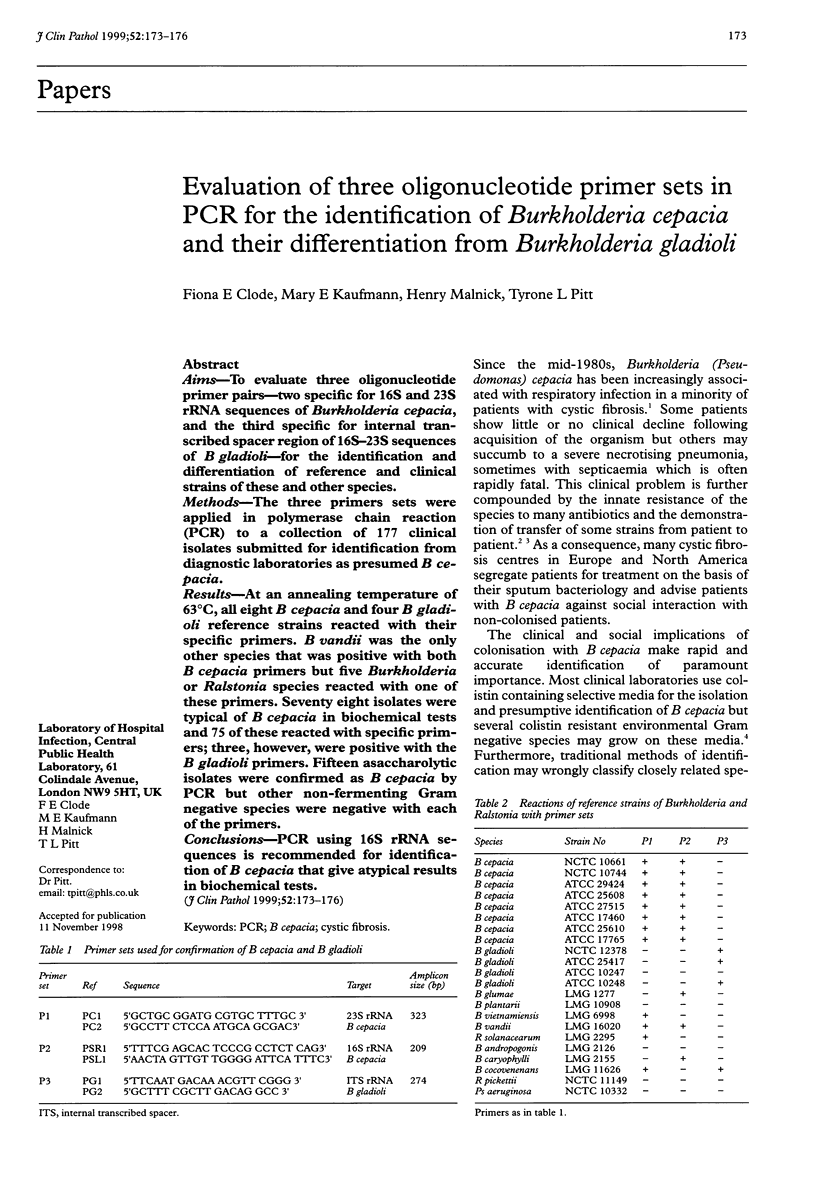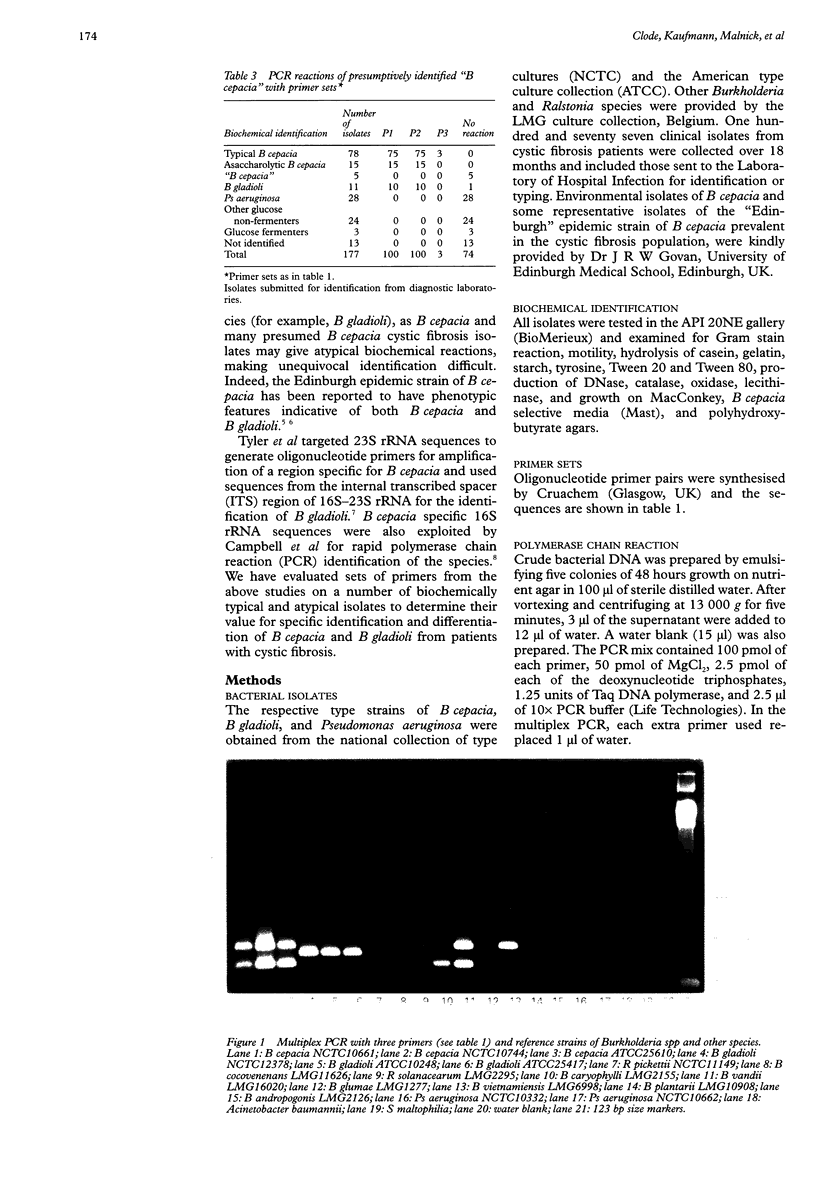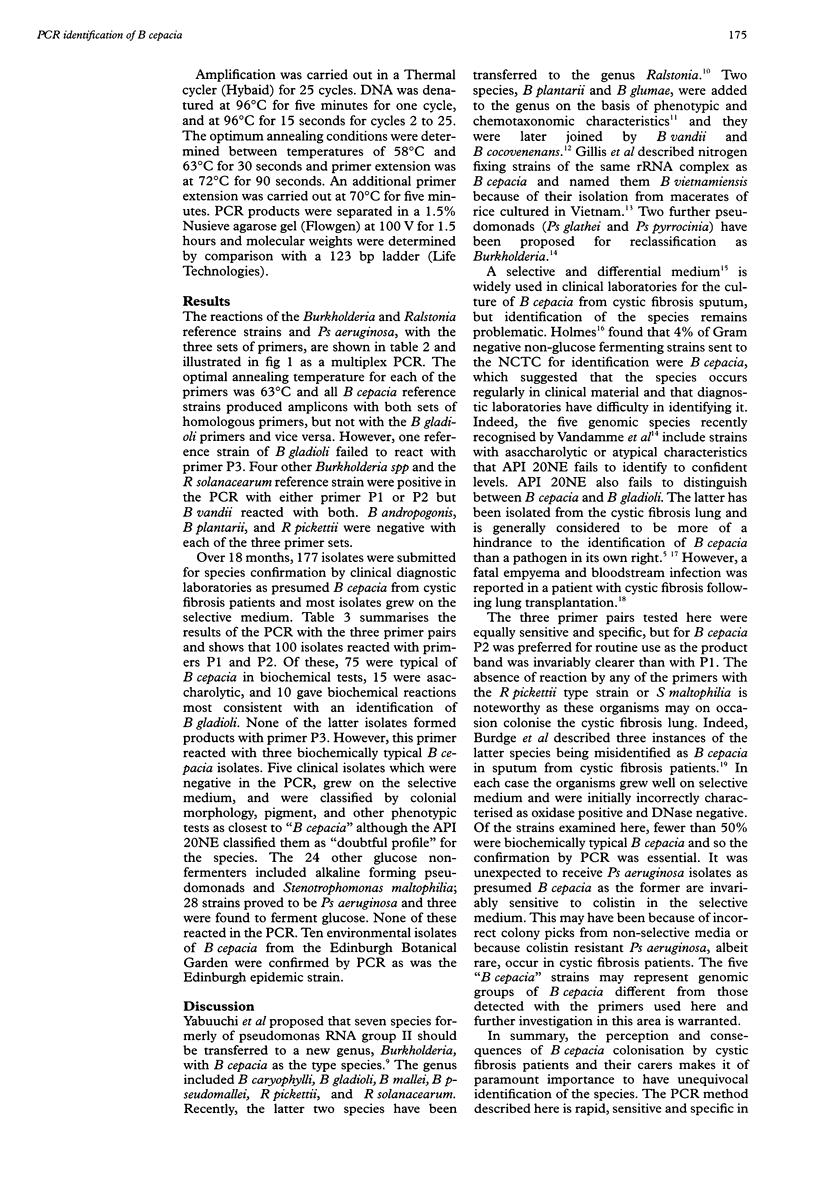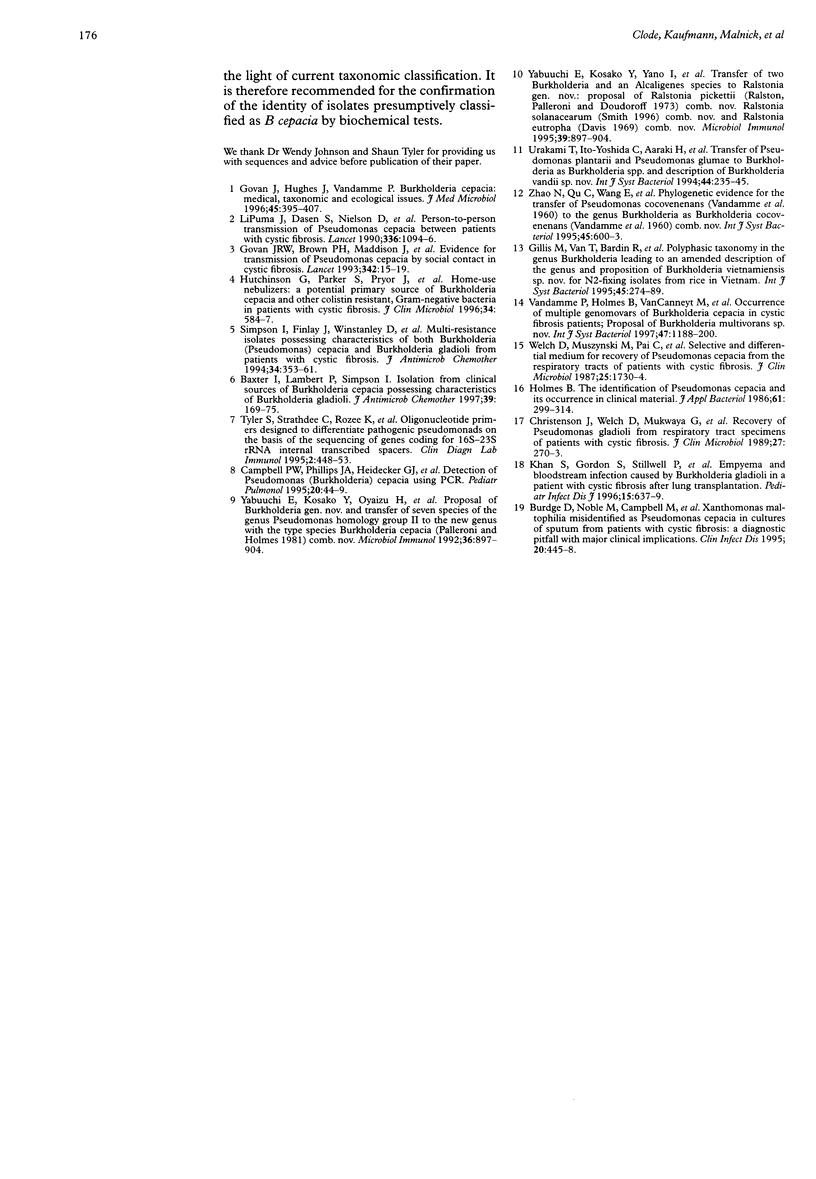Abstract
AIMS: To evaluate three oligonucleotide primer pairs--two specific for 16S and 23S rRNA sequences of Burkholderia cepacia, and the third specific for internal transcribed spacer region of 16S-23S sequences of B gladioli--for the identification and differentiation of reference and clinical strains of these and other species. METHODS: The three primers sets were applied in polymerase chain reaction (PCR) to a collection of 177 clinical isolates submitted for identification from diagnostic laboratories as presumed B cepacia. RESULTS: At an annealing temperature of 63 degrees C, all eight B cepacia and four B gladioli reference strains reacted with their specific primers. B vandii was the only other species that was positive with both B cepacia primers but five Burkholderia or Ralstonia species reacted with one of these primers. Seventy eight isolates were typical of B cepacia in biochemical tests and 75 of these reacted with specific primers; three, however, were positive with the B gladioli primers. Fifteen asaccharolytic isolates were confirmed as B cepacia by PCR but other non-fermenting Gram negative species were negative with each of the primers. CONCLUSIONS: PCR using 16S rRNA sequences is recommended for identification of B cepacia that give atypical results in biochemical tests.
Full text
PDF



Images in this article
Selected References
These references are in PubMed. This may not be the complete list of references from this article.
- Baxter I. A., Lambert P. A., Simpson I. N. Isolation from clinical sources of Burkholderia cepacia possessing characteristics of Burkholderia gladioli. J Antimicrob Chemother. 1997 Feb;39(2):169–175. doi: 10.1093/jac/39.2.169. [DOI] [PubMed] [Google Scholar]
- Burdge D. R., Noble M. A., Campbell M. E., Krell V. L., Speert D. P. Xanthomonas maltophilia misidentified as Pseudomonas cepacia in cultures of sputum from patients with cystic fibrosis: a diagnostic pitfall with major clinical implications. Clin Infect Dis. 1995 Feb;20(2):445–448. doi: 10.1093/clinids/20.2.445. [DOI] [PubMed] [Google Scholar]
- Campbell P. W., 3rd, Phillips J. A., 3rd, Heidecker G. J., Krishnamani M. R., Zahorchak R., Stull T. L. Detection of Pseudomonas (Burkholderia) cepacia using PCR. Pediatr Pulmonol. 1995 Jul;20(1):44–49. doi: 10.1002/ppul.1950200109. [DOI] [PubMed] [Google Scholar]
- Christenson J. C., Welch D. F., Mukwaya G., Muszynski M. J., Weaver R. E., Brenner D. J. Recovery of Pseudomonas gladioli from respiratory tract specimens of patients with cystic fibrosis. J Clin Microbiol. 1989 Feb;27(2):270–273. doi: 10.1128/jcm.27.2.270-273.1989. [DOI] [PMC free article] [PubMed] [Google Scholar]
- Govan J. R., Brown P. H., Maddison J., Doherty C. J., Nelson J. W., Dodd M., Greening A. P., Webb A. K. Evidence for transmission of Pseudomonas cepacia by social contact in cystic fibrosis. Lancet. 1993 Jul 3;342(8862):15–19. doi: 10.1016/0140-6736(93)91881-l. [DOI] [PubMed] [Google Scholar]
- Govan J. R., Hughes J. E., Vandamme P. Burkholderia cepacia: medical, taxonomic and ecological issues. J Med Microbiol. 1996 Dec;45(6):395–407. doi: 10.1099/00222615-45-6-395. [DOI] [PubMed] [Google Scholar]
- Holmes B. The identification of Pseudomonas cepacia and its occurrence in clinical material. J Appl Bacteriol. 1986 Oct;61(4):299–314. doi: 10.1111/j.1365-2672.1986.tb04291.x. [DOI] [PubMed] [Google Scholar]
- Hutchinson G. R., Parker S., Pryor J. A., Duncan-Skingle F., Hoffman P. N., Hodson M. E., Kaufmann M. E., Pitt T. L. Home-use nebulizers: a potential primary source of Burkholderia cepacia and other colistin-resistant, gram-negative bacteria in patients with cystic fibrosis. J Clin Microbiol. 1996 Mar;34(3):584–587. doi: 10.1128/jcm.34.3.584-587.1996. [DOI] [PMC free article] [PubMed] [Google Scholar]
- Khan S. U., Gordon S. M., Stillwell P. C., Kirby T. J., Arroliga A. C. Empyema and bloodstream infection caused by Burkholderia gladioli in a patient with cystic fibrosis after lung transplantation. Pediatr Infect Dis J. 1996 Jul;15(7):637–639. doi: 10.1097/00006454-199607000-00020. [DOI] [PubMed] [Google Scholar]
- LiPuma J. J., Dasen S. E., Nielson D. W., Stern R. C., Stull T. L. Person-to-person transmission of Pseudomonas cepacia between patients with cystic fibrosis. Lancet. 1990 Nov 3;336(8723):1094–1096. doi: 10.1016/0140-6736(90)92571-x. [DOI] [PubMed] [Google Scholar]
- Simpson I. N., Finlay J., Winstanley D. J., Dewhurst N., Nelson J. W., Butler S. L., Govan J. R. Multi-resistance isolates possessing characteristics of both Burkholderia (Pseudomonas) cepacia and Burkholderia gladioli from patients with cystic fibrosis. J Antimicrob Chemother. 1994 Sep;34(3):353–361. doi: 10.1093/jac/34.3.353. [DOI] [PubMed] [Google Scholar]
- Tyler S. D., Strathdee C. A., Rozee K. R., Johnson W. M. Oligonucleotide primers designed to differentiate pathogenic pseudomonads on the basis of the sequencing of genes coding for 16S-23S rRNA internal transcribed spacers. Clin Diagn Lab Immunol. 1995 Jul;2(4):448–453. doi: 10.1128/cdli.2.4.448-453.1995. [DOI] [PMC free article] [PubMed] [Google Scholar]
- Vandamme P., Holmes B., Vancanneyt M., Coenye T., Hoste B., Coopman R., Revets H., Lauwers S., Gillis M., Kersters K. Occurrence of multiple genomovars of Burkholderia cepacia in cystic fibrosis patients and proposal of Burkholderia multivorans sp. nov. Int J Syst Bacteriol. 1997 Oct;47(4):1188–1200. doi: 10.1099/00207713-47-4-1188. [DOI] [PubMed] [Google Scholar]
- Welch D. F., Muszynski M. J., Pai C. H., Marcon M. J., Hribar M. M., Gilligan P. H., Matsen J. M., Ahlin P. A., Hilman B. C., Chartrand S. A. Selective and differential medium for recovery of Pseudomonas cepacia from the respiratory tracts of patients with cystic fibrosis. J Clin Microbiol. 1987 Sep;25(9):1730–1734. doi: 10.1128/jcm.25.9.1730-1734.1987. [DOI] [PMC free article] [PubMed] [Google Scholar]
- Yabuuchi E., Kosako Y., Yano I., Hotta H., Nishiuchi Y. Transfer of two Burkholderia and an Alcaligenes species to Ralstonia gen. Nov.: Proposal of Ralstonia pickettii (Ralston, Palleroni and Doudoroff 1973) comb. Nov., Ralstonia solanacearum (Smith 1896) comb. Nov. and Ralstonia eutropha (Davis 1969) comb. Nov. Microbiol Immunol. 1995;39(11):897–904. doi: 10.1111/j.1348-0421.1995.tb03275.x. [DOI] [PubMed] [Google Scholar]
- Zhao N., Qu C., Wang E., Chen W. Phylogenetic evidence for the transfer of Pseudomonas cocovenenans (van Damme et al. 1960) to the genus Burkholderia as Burkholderia cocovenenans (van Damme et al. 1960) comb. nov. Int J Syst Bacteriol. 1995 Jul;45(3):600–603. doi: 10.1099/00207713-45-3-600. [DOI] [PubMed] [Google Scholar]



